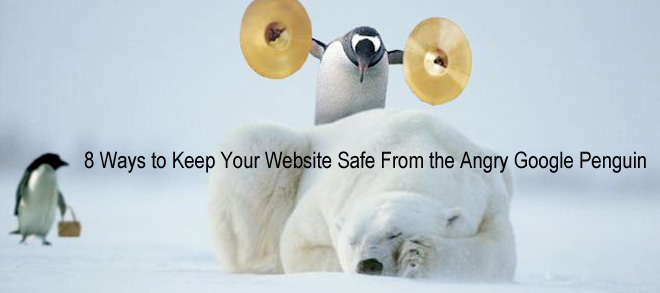Is your business safe from Google’s Panda and Penguin? Don’t let the cuddly names fool you, Penguin and Panda algorithms are out to get any web content that doesn’t live up to Google’s standards.
Despite what many in the SEO business believe, these updates are a good thing. So, how can business websites avoid these search result-crushing algorithms and keep in good standing with Google’s quality content requirements?
The Update Effect
Google’s Panda, released in early 2011, and Google Penguin, unleashed a year later, have already made some of the mightiest of websites fall. Before these updates, lower quality sites with lackluster copy were ruling the web.
Some of the key players in Google’s Webmaster witch hunt were sites like Wisegeek, Ezinearticles, and Suite101 which all dropped 75% to 95% in search result rankings. Due to keyword stuffing, linking schemes, and even deliberate plagiarism, many SEO dependent websites were left scratching their heads.
All of this is not to say that many of the companies that were initially lambasted for their content didn’t turn things around. In fact, Panda and Penguin turned out to be a way for many “thin sites” to breathe new life into their SEO practices.
The algorithms, in combination with Google’s own set of SEO guidelines, have given end-users the quality they’ve been looking for.
Survival Of The Fittest (and Highest Quality)
As stated before, Google didn’t just leave the companies that were hit by the Panda and Penguin algorithms out to dry. In order for a website to perform well in search results, it must adhere to specific guidelines that Google believes should be the standard.
So far, those companies that have followed Google’s advice aren’t only in good standing with sites like Reputation.com, they’ve naturally climbed in search results due to quality copy.
8 Tips To Keep Your Business Website Safe From Google Panda & Penguin
Here’s a few good tips how to live up to Google’s SEO standards.
1. Remove Poor Pages
A website that otherwise has solid, quality content should remove any pages that might be considered poor quality, heavily linked, or plagiarized. This is especially true for those sites that have made it a point to better their content since the Google updates but might still have a few pre-algorithm webpages in their archives.
2. Aim for Human Quality
There’s a difference between content that’s written for the reader and content that’s written for search engines. All websites should aspire for quality content with a fresh perspective that not only adds to the user’s experience, but also adds to the content that can already be found on the web.
3. Don’t Mimic
It’s true that imitation is the sincerest form of flattery, but redundancy isn’t flattering for websites trying to climb the page ranks. Google suggests adding to the content that’s already on the Internet as opposed to rehashing it. Not only does this avoid plagiarism, it makes a website’s content unique.
4. Edit – Then, Edit Again
SEO companies creating copy for clients as well as businesses writing their own copy should have dedicated editors with grammar and quality in mind. A large number of companies affected by the Google algorithms were accepting articles that slipped through the cracks of high quality editorial guidelines.
5. Link Naturally
The difference between a natural link and one that’s placed in an article solely for SEO purposes is like reading a book where the lead character’s name changes every sentence. Only add links to an article if they flow within the copy and they link to something relevant that further explains the topic at hand.
6. Don Not Duplicate Information
Duplicating webpages in attempt to achieve variable keywords is tacky and will surely result in a website being affected by the Panda algorithm in particular. Targeting various keywords is fine as long as the copy that goes along with the keywords is original.
7. Less Advertisements
Another SEO negative as far as Google is concerned is over-advertising. Websites with multiple pop-up ads or various sponsored ads that appear before the actual content are a dead giveaway that the company behind the site is in it solely for the money.
One or two tastefully placed advertisements are fine as long as they don’t make the user want to leave the site altogether.
8. Never Purchase Links
Let me repeat that:
“Never purchase links! Never!”
The reason behind the Panda and Penguin algorithms is to identify businesses which use so called “Black Hat” SEO techniques. One overwhelmingly black hat technique is the purchasing of links to gain better search results. This gives companies with the most money top priority while leaving those websites with quality in mind way down on the results list. Interflora bought some links not too long ago; they got caught up with this black hat practise, and paid for it dearly.
Google Penguin, Panda and SEO can all be friends as long as businesses have quality in mind. So, don’t think of Google as the enemy, but a way to improve Internet quality that’ll ensure crisp and original content for years to come.
What’s Next – Penguin 2.0?
Here’s the latest update from Google’s very own Matt Cutts on what’s coming up in the near future regarding the Google search algorithms:
[Image – Flickr: Chris Nystrom, Creative Commons CC BY 2.0]
Adam Groff is a freelance writer and creator of Panda and Penguin proof copy. He writes on a variety of topics ranging from personal health to home improvement.

Comments are closed.